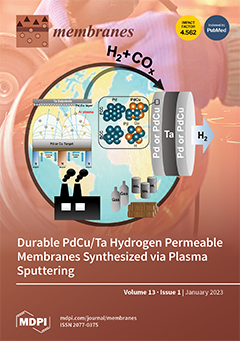To achieve a transition from conventional liquid-junction reference electrodes (LJF REs) to their all-solid-state alternatives, organic electrolytes are often introduced into the polymeric electrode membranes. In this article, we implement a theoretical approach to the explanation and quantification of the boundary potential stabilization
[...] Read more.
To achieve a transition from conventional liquid-junction reference electrodes (LJF REs) to their all-solid-state alternatives, organic electrolytes are often introduced into the polymeric electrode membranes. In this article, we implement a theoretical approach to the explanation and quantification of the boundary potential stabilization phenomenon for the electrodes modified with organic electrolytes (Q
+B
−). For the first time, stabilization of the phase boundary potential due to the partition of lipophilic ions of the Q
+B
− electrolyte between the polymeric and aqueous phases is numerically simulated to predict the LJF electrodes behavior. The impact of the hydrophilic electrolyte on the potential stabilization is demonstrated both numerically and experimentally. The developed model predicted that the small additions of a traditional ion-exchanger enhance performance of the Q
+B
−-based reference electrodes. For some specific cases, the optimal concentrations of Q
+B
− and ion-exchanger in the polymeric phase are suggested to provide stable electrode potential in a broad range of aqueous electrolyte concentrations. In addition, the efficiency of the stabilization was shown to be dependent on the overall Q
+B
− load in the polymeric membrane rather than on the closeness of the partition coefficients of the Q
+ and B
− ions; and on the volume of the aqueous phase. The model results are verified experimentally with poly(vinyl chloride) membranes containing ion-exchanger or hydrophilic electrolyte and Q
+B
− in various proportions. A good agreement between the measured electrode response and the theoretical results is observed in a broad range of solution concentrations. In particular, the cationic function of membranes containing KTpClPB is suppressed, and the electrodes begin to behave as REs starting from 50–60 mol. % of ETH500 electrolyte added to the membrane, relative to the total amount of salt.
Full article






